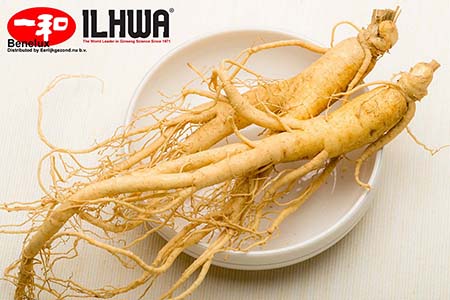The Ginseng products from ILHWA are made from Panax Ginseng. Panax Ginseng is a plant with a slow-growing solid root. It is considered to be one of the fundamental tonics in traditional Chinese medicine. In fact, it may be the world’s best-known herb. Panax ginseng has been used medicinally in Asia for more than 5000 years. In the Chinese ethnopharmacology it has been known for more than 3000 years.

Adaptogen herb
Panax derives its name from the Greek word "panacee", meaning "all-healer". Ginseng is the world’s most popular and powerful adaptogenic herb. Adaptogenic herbs assists the body to manage stress and achieve homeostatic balance. This allows the body to better resist fatigue, stress and trauma.
This has to do with the unique, active substances found only in Panax Ginseng, called ginsenosides. These are steroid-like substances that contain medicinal properties. Other plants that have the common term “ginseng” in their names are not true ginseng since they are from a different genus or family and do not contain these unique compounds. These include Siberian ginseng (Eleutherococcus senticosus), Prince ginseng (Pseudostellaria paniculate), Indian ginseng/Ashwagandha (Withania somnifera), and Brazilian ginseng/Suma (Pfaffia paniculata).
Benefits Panax Ginseng
Panax Ginseng has a remarkable capacity to restore the body’s natural balance. It supports nonspecific resistance to biochemical and physical stressors. It improves vitality and well-being.
Also shown by study, Panax Ginseng has immunomodulating activity by affecting the hypothalamic-pituitary-adrenal (HPA) axis. Clinical studies have also shown that ginseng extract:
- Aids in managing stress
- Purifies the blood of toxins
- Improves blood quality
- Assists in balancing blood sugar
- Mental clarity and focus
- Stimulates and supports digestion
- Supports strong immune system
- Helps to alkalize your body
- Helps to increase energy and vitality
Sources
1Sachse C. et al. Functional significance of a C-->A polymorphism in intron 1 of the cytochrome P450 CYP1A2 gene tested with caffeine. Br J Clin Pharmacol. 1999; 47(4):445-9.
1Cornelis MC, et al. Coffee, CYP1A2 genotype, and risk of myocardial infarction. JAMA. 2006. 295(10):1135-41.
1Heckman MA, et al. Caffeine (1, 3, 7-trimethylxanthine) in foods: a comprehensive review on consumption, functionality, safety, and regulatory matters. J Food Sci. 2010;75(3):R77-87. 1
Smit HJ. Theobromine and the pharmacology of cocoa. Handb Exp Pharmacol. 2011;(200):201-34.
1Mumford GK, et al. Absorption rate of methylxanthines following capsules, cola and chocolate. Eur J Clin Pharmacol 1996;51:319–25.
1Lakshmi T, et al. Panax Ginseng: A universal panacea in the herbal medicine pharmacological spectrum – A review. Asian Journal of Pharmaceutical and Clinical Research. 2011;4(S1):14-18.
1Thorne Research. Panax Ginseng Monograph. Alternative Medicine Review. 2009;14(2):172-176.
1Reay JL, et al. Panax ginseng improves aspects of working memory performance and subjective ratings of calmness in healthy young adults. Hum Psychopharmacol. 2010;25(6):462-71.
1Choi KT. Botanical characteristics, pharmacological effects and medicinal components of Korean Panax ginseng C A Meyer. Acta Pharmacol Sin. 2008; 29 (9): 1109–1118.
1Ko SK, et al. Analysis of Ginsenosides of White and Red Ginseng Concentrates. Korean Food Science and Technology. 2003;35:536-539.
1Xiang-guo L, et al. Ginsenoside Content in The Leaves and Roots of Panax ginseng at Different Ages. Life Science Journal. 2012;9(4):679-683.
1Leung KW and Wong AST. Pharmacology of ginsenosides: a literature review. Chinese Medicine. 2010; 5(20):1- 7.
1Hasagawa H. Proof of mysterious efficacy of ginseng: basic and clinical trials: Metabolic activation of ginsenoside: Deglycosylation by intestinal bacteria and esterification with fatty acid. Journal of Pharmacological Sciences. 2004;95:153-157.
1Ramesh T, et al. Effect of fermented Panax ginseng extract (GINST) on oxidative stress and antioxidant activities in major organs of aged rats. Exp Gerontol. 2012 . 47(1):77-84.
1Kitaoka K et al. Fermented Ginseng Improves the First-Night Effect in Humans. Sleep. 2009;32(3):413-421.
1Lee HU, et al. Hepatoprotective effect of ginsenoside Rb1 and compound K on tert-butyl hydroperoxide-induced liver injury. Liver International. 2005;25: 1069–1073.
1Yang CS, et al. Compound K (CK) Rich Fractions from Korean Red Ginseng Inhibit Toll-like Receptor (TLR) 4- or TLR9-mediated Mitogen-activated Protein Kinases Activation and Pro-inflammatory Responses in Murine Macrophages. Journal of Ginseng Research. 2007; 31( 4): 181-190.
1Yuan HD, et al. Beneficial effects of IH-901 on glucose and lipid metabolisms via activating adenosine monophosphate–activated protein kinase and phosphatidylinositol-3 kinase pathways. Metabolism Clinical and Experimental. 2011;60: 43–51.
iLakshmi T, et al. Panax Ginseng: A universal panacea in the herbal medicine pharmacological spectrum – A review. Asian Journal of Pharmaceutical and Clinical Research. 2011;4(S1):14-18.
ii Thorne Research. Panax Ginseng Monograph. Alternative Medicine Review. 2009;14(2):172-176.
iii Reay JL, et al. Panax ginseng improves aspects of working memory performance and subjective ratings of calmness in healthy young adults. Hum Psychopharmacol. 2010;25(6):462-71.
iv Choi KT. Botanical characteristics, pharmacological effects and medicinal components of Korean Panax ginseng C A Meyer. Acta Pharmacol Sin. 2008; 29 (9): 1109–1118.
vKo SK, et al. Analysis of Ginsenosides of White and Red Ginseng Concentrates. Korean Food Science and Technology. 2003;35:536-539.
vi Xiang-guo L, et al. Ginsenoside Content in The Leaves and Roots of Panax ginseng at Different Ages. Life Science Journal. 2012;9(4):679-683.
vii Leung KW and Wong AST. Pharmacology of ginsenosides: a literature review. Chinese Medicine. 2010; 5(20):1-7.
viii Hasagawa H. Proof of mysterious efficacy of ginseng: basic and clinical trials: Metabolic activation of ginsenoside: Deglycosylation by intestinal bacteria and esterification with fatty acid. Journal of Pharmacological Sciences. 2004;95:153-157.
ixRamesh T, et al. Effect of fermented Panax ginseng extract (GINST) on oxidative stress and antioxidant activities in major organs of aged rats. Exp Gerontol. 2012 . 47(1):77-84.
xKitaoka K et al. Fermented Ginseng Improves the First-Night Effect in Humans. Sleep. 2009;32(3):413-421.
xi Lee HU, et al. Hepatoprotective effect of ginsenoside Rb1 and compound K on tert-butyl hydroperoxide-induced liver injury. Liver International. 2005;25: 1069–1073.
xii Yang CS, et al. Compound K (CK) Rich Fractions from Korean Red Ginseng Inhibit Toll-like Receptor (TLR) 4- or TLR9-mediated Mitogen-activated Protein Kinases Activation and Pro-inflammatory Responses in Murine Macrophages. Journal of Ginseng Research. 2007; 31( 4): 181-190.
xiii Yuan HD, et al. Beneficial effects of IH-901 on glucose and lipid metabolisms via activating adenosine monophosphate–activated protein kinase and phosphatidylinositol-3 kinase pathways. Metabolism Clinical and Experimental. 2011;60: 43–51.
